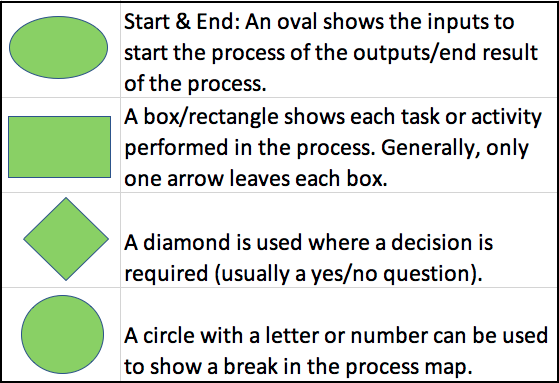A process map is a workflow diagram developed to document activities across a process.
Taking a step back, a process is simply a series of steps that we go through in order to complete a task or achieve some specific purpose--in other words, how do things get done? Our daily lives involve many processes, either at work or as a consumer. In this tutorial, we will focus on a consumer example.
When we take a process, break it down into various steps, show it pictorially, we can make a process map.
To start, you would write out a very detailed narrative of the process and all of the steps involved.
Next, you would turn the steps into a pictorial diagram using these symbols.

You may recall that in microeconomics, we study the individual firm and the individual consumer. We know that both firms and individuals are involved in processes every day.
EXAMPLE
Suppose you are hungry and want to order pizza. What are the steps involved in your ultimate decision, as a consumer, regarding where to order the pizza, how much you are willing to pay for the pizza, and whether you are a repeat customer. This would be an example of a consumer decision-making flow chart.EXAMPLE
Two examples of a firm flowchart might involve their process of scheduling appointments or taking an order, allowing them to evaluate if their process is the most efficient way to accomplish these tasks.Here is an example of a process map detailing a consumer's decision-making process about being hungry for pizza.

The oval represents the input that starts the process: I am hungry for pizza. What to do about it?
The first step in the process is to consider where to get pizza--an activity represented by a rectangle.
Then, a question arises. Do I have loyalty to a certain place? Is there somewhere that I always order from, that I want to order from again?
If the answer is yes, then the process ends with me placing my order.
If the answer is no, I go through more steps, represented by more rectangles, such as looking at ads or coupons and deciding which deal or offer is most attractive.
After completing these tasks, once again, the process ends with me placing my order.
Now, process maps can be a lot more detailed than this. They can involve a lot more steps and questions.
For instance, I could have taken this from where I place my order and continued on with the next process, such as:
As mentioned, though, this is a very simplified example of how the decision-making process is represented pictorially.
Here is a process map detailing an individual's side business of selling baseball cards on eBay to generate some extra income.

The oval indicates the beginning of the process. He has baseball cards that are ready to post on eBay.
In this process map, we don't have an activity first; instead, we have a question. He has to decide, when he's posting his cards on eBay, if he should put them in as auction, buy it now, or best offer.
Typically, this is a "yes" or "no" question, but here you can see there are three choices.
In all three cases, he's simply posting it on eBay, so there is not a different way branching off of each question. He just has to decide whether to post it as auction, buy it now, or best offer.
Once he makes that decision, he puts it on eBay and the order is received.
Once his order is received, he has to see whether the customer is going to pay by PayPal or check.
If they pay by a check, a question comes up: did he receive the check? He needs to wait to receive payment in order to sell it, or release the card.
If he does receive the check, the card gets packaged. He figures out the insurance and delivery confirmation at the post office, and then he sends out an invoice or receipt and ships the card.
These are all the steps in the process to land at our end result with the card being shipped.
However, if he doesn't receive the check in the mail, then the order is canceled and he reposts the card.
If he receives payment via PayPal, the process simply continues as if he had received the check.